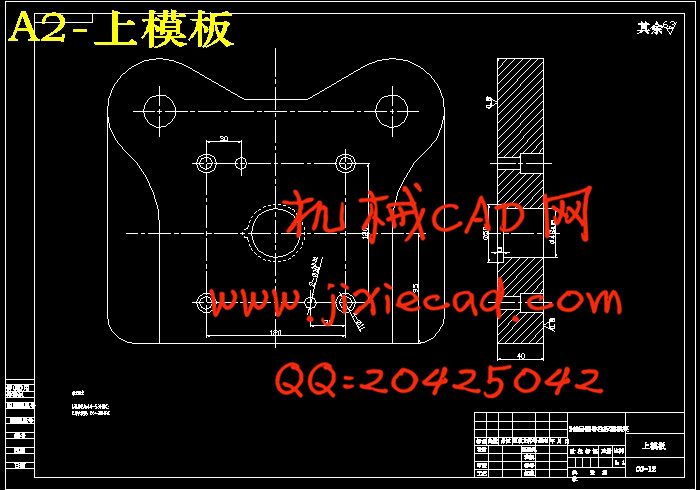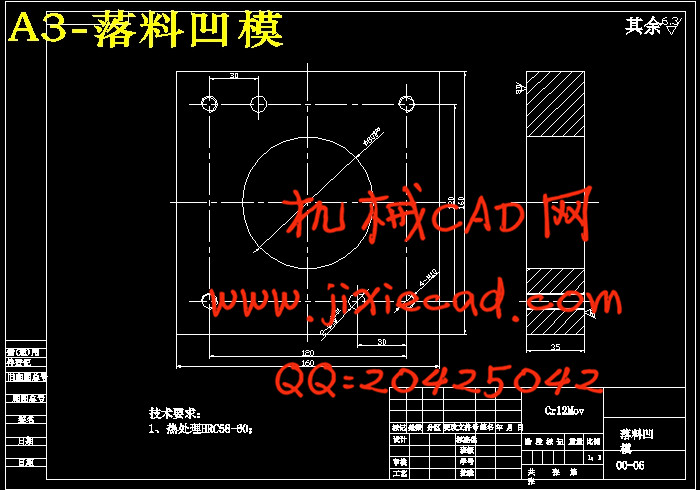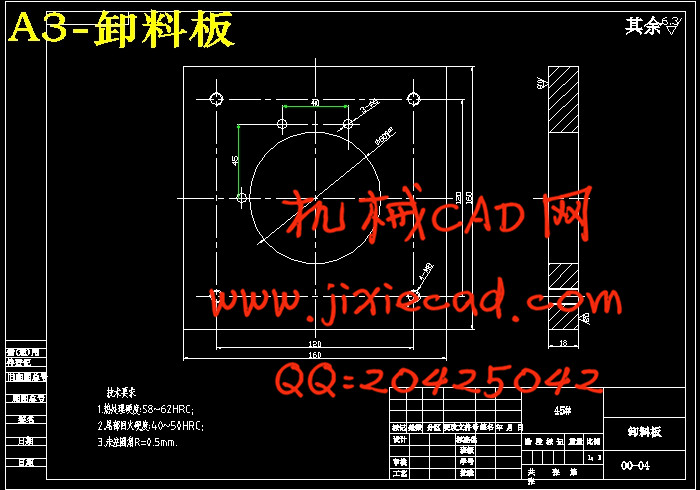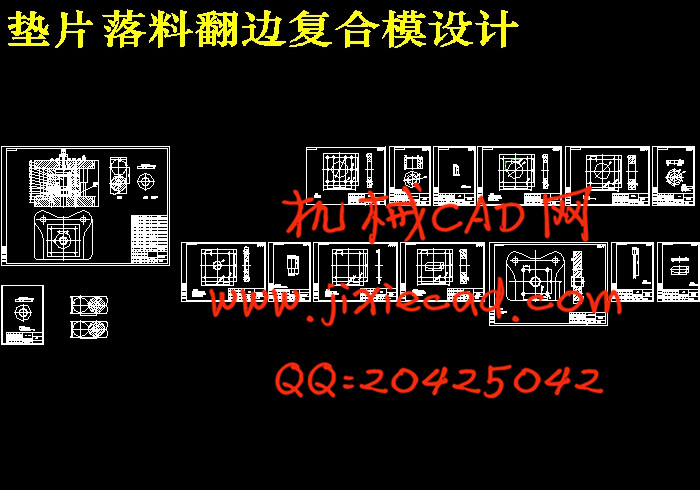设计简介
摘 要
本次设计了一套冲孔﹑落料、翻边的复合模模具。经过查阅资料,首先要对零件进行工艺分析,经过工艺分析和对比,采用冲孔落料翻边工序,通过冲裁力、顶件力、卸料力等计算,确定模具的类型。得出将设计的模具类型后将模具的各工作零部件设计过程表达出来。
在论文中第一部分,主要叙述了冲压模具的发展状况,说明了冲压模具的重要性,接着是对冲压件的工艺分析,完成了工艺方案的确定。第二部分,对零件排样图的设计,完成了材料利用率的计算。再进行冲裁工艺力的计算和冲裁模工作部分的设计计算,对选择冲压设备提供依据。最后对主要零部件的设计和标准件的选择,为本次设计模具的绘制和模具的成形提供依据。通过前面的设计方案画出模具各零件图和装配图。
本模具性能可靠,运行平稳,能够适应大批量生产要求,提高了产品质量和生产效率,降低劳动强度和生产成本。
关键词:冲压;复合模;模具结构
Abstract
The design of the compound die punching, blanking, a flanging. Through access to information, the first part to process analysis, through process analysis and comparison, the punching flanging die, punching through, the top pieces, such as the discharge of calculation, determine the type of die. The design of the mold type after the working parts mold design process of expression.
In the first part, mainly describes the development of stamping dies, illustrates the importance of stamping dies, then stamping process is analyzed to determine the completion of the process plan. The second part, the part layout diagram design, complete the calculation of material utilization. Then the blanking force calculation and design calculation of blanking die working parts, provide the basis for the selection of stamping equipment. Finally the design and standards on the main parts selection, provide the basis for drawing and the mould forming the mold design. The design drawing mold parts drawing and assembly drawing.
The die is reliable performance, stable running, able to adapt to the requirement of mass production, improve product quality and production efficiency, reduce labor intensity and production cost.
Keywords: punching compound die; die structure
目 录
摘 要 I
第一章 概论 1
1.2冲压模地位及我国冲压技术 1
1.2.1冲压模相关介绍 1
1.2.2冲模在现代工业生产中的地位 1
1.2.3我国冲压模具市场情况 2
1.2.4 冲压模具水平状况 3
1.2.5我国冲模今后发展趋势 5
1.3总结 5
第二章 工件工艺性分析及方案确定 6
2.1工件工艺性分析 6
2.1.1冲裁工艺性 6
2.1.2翻边工艺性 6
2.1.3判断能否一次性翻边成形 7
2.2 工艺方案确定 7
第三章 排样及计算材料利用率 10
3.1计算预冲孔大小 10
3.2确定排样方式 10
3.3计算材料利用率 11
第四章 冲裁力及压力中心计算 14
4.1.落料力F落 14
4.2卸料力F 卸 14
4.3冲孔力F冲 14
4.4顶件力F顶 15
4.5翻边力F翻 15
4.6总冲压力F总 15
4.7计算压力中心 15
第五章 主要工作部分尺寸计算 16
5.1落料刃口尺寸 16
5.2冲孔刃口尺寸 16
5.3翻边工作刃口尺寸 17
5.3.1翻边间隙 17
5.3.2翻边刃口尺寸 18
第六章 凸模、凹模及凸凹模的结构设计及校核 19
6.1落料凹模结构设计 19
6.1.1最小壁厚 19
6.1.2模具材料的选择 19
6.1.3确定凹模外形尺寸 20
6.1.4凹模的强度校核 21
6.2凸凹模外形尺寸 21
6.3冲孔凸模外形尺寸 23
第七章 主要零部件设计 26
7.1模柄的设计 26
7.2固定板和垫板的设计 26
7.2.1冲孔、翻边凸凹模固定板的设计 26
7.2.2冲孔凸模固定板的设计 27
7.2.3垫板的设计 28
第八章 冲压设备的校核与选定 29
8.1 冲压设备的校核 29
8.2 冲压设备的选用 29
第九章 绘制模具总装图及零件图 30
9.1装配图绘制 30
致 谢 31
参考文献 32
本次设计了一套冲孔﹑落料、翻边的复合模模具。经过查阅资料,首先要对零件进行工艺分析,经过工艺分析和对比,采用冲孔落料翻边工序,通过冲裁力、顶件力、卸料力等计算,确定模具的类型。得出将设计的模具类型后将模具的各工作零部件设计过程表达出来。
在论文中第一部分,主要叙述了冲压模具的发展状况,说明了冲压模具的重要性,接着是对冲压件的工艺分析,完成了工艺方案的确定。第二部分,对零件排样图的设计,完成了材料利用率的计算。再进行冲裁工艺力的计算和冲裁模工作部分的设计计算,对选择冲压设备提供依据。最后对主要零部件的设计和标准件的选择,为本次设计模具的绘制和模具的成形提供依据。通过前面的设计方案画出模具各零件图和装配图。
本模具性能可靠,运行平稳,能够适应大批量生产要求,提高了产品质量和生产效率,降低劳动强度和生产成本。
关键词:冲压;复合模;模具结构
Abstract
The design of the compound die punching, blanking, a flanging. Through access to information, the first part to process analysis, through process analysis and comparison, the punching flanging die, punching through, the top pieces, such as the discharge of calculation, determine the type of die. The design of the mold type after the working parts mold design process of expression.
In the first part, mainly describes the development of stamping dies, illustrates the importance of stamping dies, then stamping process is analyzed to determine the completion of the process plan. The second part, the part layout diagram design, complete the calculation of material utilization. Then the blanking force calculation and design calculation of blanking die working parts, provide the basis for the selection of stamping equipment. Finally the design and standards on the main parts selection, provide the basis for drawing and the mould forming the mold design. The design drawing mold parts drawing and assembly drawing.
The die is reliable performance, stable running, able to adapt to the requirement of mass production, improve product quality and production efficiency, reduce labor intensity and production cost.
Keywords: punching compound die; die structure
目 录
摘 要 I
第一章 概论 1
1.2冲压模地位及我国冲压技术 1
1.2.1冲压模相关介绍 1
1.2.2冲模在现代工业生产中的地位 1
1.2.3我国冲压模具市场情况 2
1.2.4 冲压模具水平状况 3
1.2.5我国冲模今后发展趋势 5
1.3总结 5
第二章 工件工艺性分析及方案确定 6
2.1工件工艺性分析 6
2.1.1冲裁工艺性 6
2.1.2翻边工艺性 6
2.1.3判断能否一次性翻边成形 7
2.2 工艺方案确定 7
第三章 排样及计算材料利用率 10
3.1计算预冲孔大小 10
3.2确定排样方式 10
3.3计算材料利用率 11
第四章 冲裁力及压力中心计算 14
4.1.落料力F落 14
4.2卸料力F 卸 14
4.3冲孔力F冲 14
4.4顶件力F顶 15
4.5翻边力F翻 15
4.6总冲压力F总 15
4.7计算压力中心 15
第五章 主要工作部分尺寸计算 16
5.1落料刃口尺寸 16
5.2冲孔刃口尺寸 16
5.3翻边工作刃口尺寸 17
5.3.1翻边间隙 17
5.3.2翻边刃口尺寸 18
第六章 凸模、凹模及凸凹模的结构设计及校核 19
6.1落料凹模结构设计 19
6.1.1最小壁厚 19
6.1.2模具材料的选择 19
6.1.3确定凹模外形尺寸 20
6.1.4凹模的强度校核 21
6.2凸凹模外形尺寸 21
6.3冲孔凸模外形尺寸 23
第七章 主要零部件设计 26
7.1模柄的设计 26
7.2固定板和垫板的设计 26
7.2.1冲孔、翻边凸凹模固定板的设计 26
7.2.2冲孔凸模固定板的设计 27
7.2.3垫板的设计 28
第八章 冲压设备的校核与选定 29
8.1 冲压设备的校核 29
8.2 冲压设备的选用 29
第九章 绘制模具总装图及零件图 30
9.1装配图绘制 30
致 谢 31
参考文献 32


















